Standard [CURRENT]
ASTM E 3408/E 3408M:2025
Standard Test Methods for Evaluating Ground Response Robot Capabilities: Dexterity: Inspect
- Publication date
- 2025
- Original language
- English
- Pages
- 31
- Publication date
- 2025
- Original language
- English
- Pages
- 31
- DOI
- https://dx.doi.org/10.1520/E3408_E3408M-25
Product information on this site:
Quick delivery via download or delivery service
Buy securely with a credit card or pay upon receipt of invoice
All transactions are encrypted
Short description
1.1 These test methods are intended for remotely operated ground robots operating in complex, unstructured, and often hazardous environments. They specify the apparatuses, procedures, and performance metrics necessary to measure the capability of a robot to dexterously inspect objects of interest in the environment at various heights, depths, orientations, and confinement. This standard is one of several related dexterity tests that can be used to evaluate overall system capabilities. Three test methods are included in this standard: linear dexterity, omni-directional dexterity, and combination dexterity. All test methods use the same apparatus components (Section 6 ), pose the same hazards (Section 7 ), use the same procedure (Section 8 ), the same precision and bias (Section 9 ), and the same keywords (Section 16 ). The combination dexterity test method uses additional apparatus components (Section 10 ), has its own metrics (Section 11 ), and report (Section 12 ). The linear dexterity and omni-directional dexterity test methods use additional apparatus components (Section 13 ), their own metrics (Section 14 ), and report (Section 15 ). Appendix X2 contains example filled out report forms for all test methods. 1.2 The robotic system typically includes a remote operator in control of all functionality, so an onboard camera and remote operator display are typically required. Assistive features or autonomous behaviors may improve the effectiveness or efficiency of the overall system. 1.3 Different user communities can set their own thresholds of acceptable performance within these test methods for various mission requirements. 1.4 Performing Location- These test methods may be performed anywhere the specified apparatuses and environmental conditions can be implemented. 1.5 Units- The International System of Units (SI Units) and U.S. Customary Units (Imperial Units) are used throughout this test method. They are not mathematical conversions. Rather, they are approximate equivalents in each system of units to enable use of readily available materials in different countries. The differences between the stated dimensions in each system of units are insignificant for the purposes of comparing test method results, so each system of units is separately considered standard within these test methods. 1.6 This standard does not purport to address all of the safety concerns, if any, associated with its use. It is the responsibility of the user of this standard to establish appropriate safety, health, and environmental practices and determine the applicability of regulatory limitations prior to use. 1.7 This international standard was developed in accordance with internationally recognized principles on standardization established in the Decision on Principles for the Development of International Standards, Guides and Recommendations issued by the World Trade Organization Technical Barriers to Trade (TBT) Committee.
ICS
13.200,
25.040.30
DOI
https://dx.doi.org/10.1520/E3408_E3408M-25
Also available in
Loading recommended items...
Loading recommended items...
Loading recommended items...
Loading recommended items...

